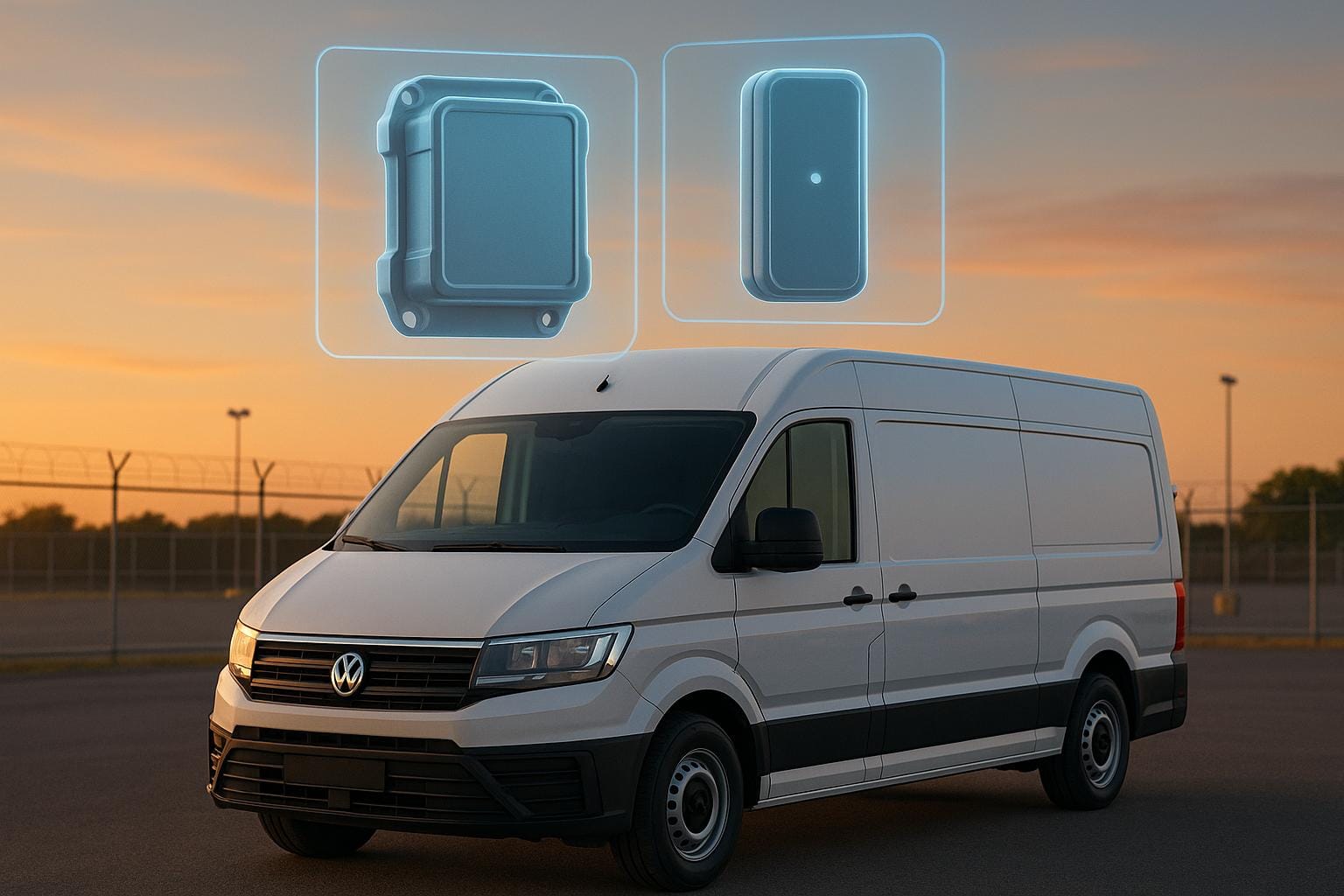Dual-Tracker Systems for Fleet Security
Explore how dual-tracker systems enhance fleet security, providing higher recovery rates and better protection against modern theft techniques.

Fleet security in the UK is under threat as vehicle thefts have surged by 75% over the past decade, with 129,159 vehicles stolen in 2024 alone. Keyless car thefts now make up over 60% of these cases. Traditional tracking systems are struggling to keep up with advanced theft techniques like relay attacks and signal jamming. Dual-tracker systems are emerging as a stronger solution, offering recovery rates of up to 91% compared to the national average of 46%.
Here’s why dual-tracker systems are a game-changer:
- Two Devices for Redundancy: If one tracker is disabled, the second ensures uninterrupted tracking.
- Jamming Resistance: Dual systems counter signal interference, a common flaw in single-trackers.
- Higher Recovery Rates: Vehicles with dual-trackers are far more likely to be recovered.
- Affordable Options: Starting at £35 for hardware and £7.99/month, they offer strong value for fleets.
For high-value vehicles or fleets operating in theft-prone areas, dual-trackers provide added security and peace of mind. Compared to single-trackers, they are a step ahead in reliability and theft prevention.
Teltonika Vehicle Double Security Solution

1. Single-Tracker Systems
Single-tracker systems rely on GPS/GNSS technology to monitor vehicle locations. They include a hardware device installed in the vehicle and software that processes and displays tracking data through web and mobile platforms.
Core Components and How They Work
The hardware typically features a GNSS receiver to gather location data, a 4G/5G module for data transmission, and sensors that detect events such as harsh driving or unauthorised movement. The software processes this information and makes it accessible via live maps, alerts, and detailed reports.
Installation options vary and include:
- Hard-wired systems: Discreetly connected to the vehicle's 12V power supply.
- Plug-in devices: Connected through the OBD port.
- Battery-operated trackers: Independent units that report location less frequently.
The choice of hardware and installation method can directly affect the system's ability to recover stolen vehicles.
Security Performance and Recovery Success
When part of a well-coordinated programme, single-tracker systems can achieve recovery rates between 70% and 90%, provided the devices remain active and responses are timely. In these cases, stolen vehicles are often recovered much faster than untracked ones, with retrieval times sometimes measured in just a few hours.
Vulnerabilities and Signal Limitations
These systems depend heavily on GPS signals, which are inherently weak and prone to interference. Even minor disruptions can affect performance. Criminals exploit this vulnerability with low-cost jamming devices, available for as little as £15, to block signals. Spoofing attacks, where fake GPS signals mislead the tracker, can further complicate recovery efforts if not identified and addressed.
Costs to Consider
The price of anti-theft devices ranges widely, from £4 to over £625, with additional subscription fees required for full functionality. Investing in professional installation, especially for hard-wired devices with tamper detection, can improve system effectiveness. While battery-operated options are cheaper and easier to install, they may fall short in reliability, particularly during sophisticated theft attempts. Balancing these costs against the potential expense of replacing a stolen vehicle is a key consideration.
Real-World Challenges
Single-tracker systems face significant limitations during organised theft operations. In less integrated systems or when devices are disabled, recovery rates can drop to 30–40%. Environmental factors like signal shadowing in dense urban areas, interference from other electronic devices, and multipath fading can further reduce accuracy and reliability. These challenges underscore the risks of relying solely on a single tracking method.
2. Dual-Tracker Systems
Dual-tracker systems take fleet security to the next level by using two separate GPS tracking devices in a single vehicle. This setup ensures continuous monitoring, even if one of the devices is tampered with or disabled. By addressing the vulnerabilities of single-trackers, dual-trackers provide a more reliable and consistent way to keep vehicles secure.
Architecture and Communication
A dual-tracker system typically includes a primary device that actively monitors vehicle activity, while a secondary tracker remains in standby mode, using minimal power. These devices communicate via Bluetooth, allowing the backup tracker to detect if the primary unit has been compromised. If the primary tracker is disabled, the secondary tracker immediately takes over and sends alert notifications. Industry research supports this design, highlighting its ability to reduce risks and enable advanced communication protocols.
Superior Recovery Performance
The effectiveness of dual-tracker systems is evident in their recovery rates. Stolen vehicles equipped with dual-trackers boast a 91% recovery rate, far exceeding the approximately 20% recovery rate for untracked vehicles in the USA. This success stems from the system’s ability to maintain uninterrupted location data, even if thieves attempt to disable the primary device.
Enhanced Security Capabilities
"Anything that makes car thieves or joy-riders spend more time on a vehicle to steal it and get confused in the process makes it a much less tempting target." - Teltonika-GPS.com
Dual-trackers offer more than just tracking - they add an extra layer of security. By making it harder for criminals to tamper with or disable the system, they act as a deterrent and reduce the likelihood of theft.
Signal Jamming Resistance
One of the standout features of dual-trackers is their resistance to signal jamming. Inexpensive jamming devices can disrupt single-trackers, but a dual-tracker setup ensures that if one unit is jammed, the other continues to transmit accurate location data. This added resilience makes dual-trackers a worthwhile investment for those prioritising security.
Cost Considerations and Value
While dual-tracker systems come with a higher upfront cost compared to single-trackers, their long-term benefits make them a smart choice. GRS Fleet Telematics offers dual-tracker systems starting at £7.99 per vehicle per month, with hardware prices ranging from £35 to £99, making them accessible for many fleets.
Here’s a quick comparison to highlight the value:
| System Type | Hardware Cost | Monthly Fee | Recovery Rate |
|---|---|---|---|
| GRS Enhanced (Dual) | £79 | £7.99 | 85% |
| GRS Ultimate (Dual + Immobilisation) | £99 | £7.99 | 91% |
| Market Average (Single) | £34–£199 | £5–£35 | 46–71% |
Given their reliability and security advantages, dual-tracker systems are especially beneficial for high-value vehicles or fleets operating in areas with higher theft risks.
Advantages and Disadvantages
When deciding between single-tracker and dual-tracker systems, understanding their strengths and weaknesses can help make smarter security investments. Below, we break down the key differences to help guide your decision-making.
Single-tracker systems are budget-friendly and straightforward to install. However, they have a major vulnerability: if the tracker is jammed or disabled, the vehicle becomes untraceable.
Dual-tracker systems, on the other hand, address these weaknesses by offering redundancy and enhanced reliability. As GRS Fleet Telematics explains:
"Dual-tracker systems offer a higher level of reliability and security compared to single GPS trackers, making them an excellent option for van recovery. With two tracking devices in place, these systems provide a backup if one tracker is tampered with, disabled, or encounters technical problems. This extra layer of protection greatly boosts the chances of recovering stolen vehicles."
Thatcham-approved dual-tracker systems boast recovery rates as high as 96%, a stark contrast to the 39% recovery rate often associated with single-tracker systems. While dual-tracker systems come with a higher upfront cost, their improved security and recovery performance can make them a worthwhile investment.
Here’s a quick comparison of the two systems:
| Feature | Single-Tracker Systems | Dual-Tracker Systems |
|---|---|---|
| Recovery Rate | Around 39% (police rate) | Up to 96% (Thatcham-approved) |
| Security Features | Basic GPS tracking | GPS tracking with backup and jamming resistance |
| Reliability | Vulnerable to single failure | Redundant protection with continuous monitoring |
| Cost-Effectiveness | Lower initial cost | Higher upfront investment for better security |
One standout advantage of dual-tracker systems is their resistance to signal jamming. In an era where jamming devices are easily accessible, single-tracker solutions can be rendered useless if jammed. Dual-tracker systems, however, remain operational by leveraging secondary communication methods, ensuring continued tracking.
The choice between these systems ultimately depends on your specific needs. For high-value vehicles, fleets operating in theft-prone areas, or businesses that cannot afford disruptions, dual-tracker systems provide the extra layer of security required. Meanwhile, smaller fleets or those operating in low-risk environments might find single-tracker systems sufficient for their needs.
Conclusion
Dual-tracker systems offer a level of redundancy and reliability that is crucial for modern fleet security in the UK. While single-tracker solutions may provide basic protection at a lower cost, they fall short when faced with advanced threats like signal jamming. Dual-trackers, on the other hand, ensure continuous tracking by using a backup unit if the primary one fails. This added layer of security translates to higher recovery rates and reduced operational risks.
Take, for example, the performance of GRS Fleet Telematics' dual-tracker technology, which boasts an impressive 91% recovery rate - one of the highest in the industry. This significantly reduces financial losses and minimises disruptions to operations, giving fleet managers peace of mind.
For UK fleet managers, the benefits make a strong case for investment. Many fleets recover their costs within 6–12 months, thanks to fewer theft-related losses, lower insurance premiums, and improved efficiency. With pricing starting at just £35 for hardware and £7.99 per month, this technology is both effective and affordable.
The system’s ability to operate seamlessly across borders is especially beneficial for fleets with European operations. Real-world successes underline its value. For instance, in one operation, law enforcement made 67 arrests, while in another case, a heavy-duty truck near the Musina border was quickly recovered because the backup tracker stayed active even after the primary unit was compromised.
For fleets managing high-value vehicles, operating in theft-prone areas, or requiring cross-border protection, dual-trackers are no longer optional - they're essential. In today's challenging security environment, relying on anything less could prove costly.
FAQs
How do dual-tracker systems offer better vehicle theft protection than single-tracker systems?
Dual-tracker systems offer a robust solution for vehicle theft protection by combining two types of tracking technology. The first tracker provides real-time location updates, ensuring you always know where your vehicle is. The second tracker acts as a backup, maintaining monitoring even if the primary system is tampered with or disabled.
This two-layered setup not only increases the chances of recovering stolen vehicles but also speeds up response times with real-time alerts. By making it more difficult for thieves to bypass the tracking system, dual-trackers serve as a powerful deterrent and improve the odds of a swift recovery.
How much do dual-tracker systems cost, and are they worth the investment for fleet security?
The installation cost of dual-tracker systems in the UK usually falls between £200 and £500, with ongoing monthly fees starting at approximately £10 to £15. While this might seem like a significant initial expense, the potential savings from theft recovery can make it well worth the investment. Dual-trackers are particularly effective, with recovery rates reaching an impressive 91%.
By cutting down the chances of vehicle loss and the expenses that come with it, these systems often end up covering their own cost over time. For fleets that include high-value vehicles, dual-trackers provide a dependable and budget-friendly way to strengthen security and reduce financial risks.
Can dual-tracker systems work with existing fleet management software, and how do they improve efficiency?
Dual-tracker systems can work effortlessly with your current fleet management software, bringing a host of benefits to your operations. With real-time location tracking, fleet managers can keep an eye on vehicle movements, fine-tune routes, and ensure deliveries stay on schedule.
These systems also offer alerts in advance, like maintenance reminders or theft warnings, which help cut down on unexpected downtime and manage expenses more effectively. By providing greater visibility and control, dual-tracker technology simplifies operations, boosts productivity, and aids in making smarter decisions for your fleet.
